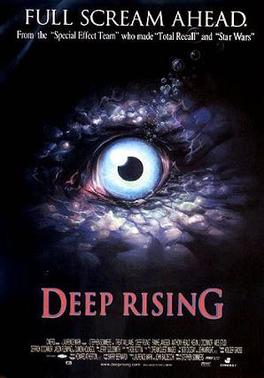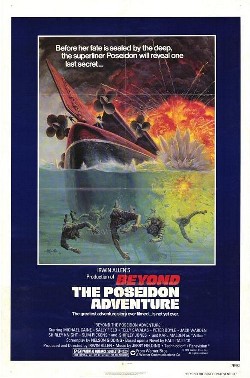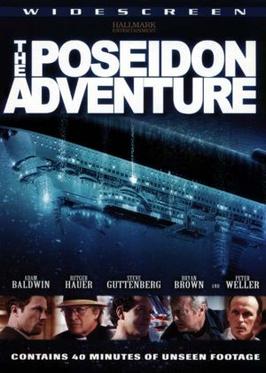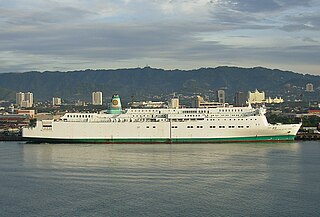
HMHSBritannic was the third and final vessel of the White Star Line's Olympic class of steamships and the second White Star ship to bear the name Britannic. She was the youngest sister of the RMS Olympic and the RMS Titanic and was intended to enter service as a transatlantic passenger liner. She was operated as a hospital ship from 1915 until her sinking near the Greek island of Kea, in the Aegean Sea, in November 1916. At the time she was the largest hospital ship in the world.

A disaster film or disaster movie is a film genre that has an impending or ongoing disaster as its subject and primary plot device. Such disasters may include natural disasters, accidents, military/terrorist attacks or global catastrophes such as a pandemic. A subgenre of action films, these films usually feature some degree of build-up, the disaster itself, and sometimes the aftermath, usually from the point of view of specific individual characters or their families or portraying the survival tactics of different people.

SS Andrea Doria was a luxury transatlantic ocean liner of the Italian Line, put into service in 1953. She is widely known from the extensive media coverage of her sinking in 1956, which included the remarkably successful rescue of 1,660 of her 1,706 passengers and crew.

The Poseidon Adventure is a 1972 American disaster film directed by Ronald Neame, produced by Irwin Allen, and based on Paul Gallico's 1969 novel of the same name. It has an ensemble cast including five Oscar winners: Gene Hackman, Ernest Borgnine, Jack Albertson, Shelley Winters, and Red Buttons. The plot centers on the fictional SS Poseidon, an aging luxury liner on her final voyage from New York City to Athens, before it is scrapped. On New Year's Day, it is overturned by a tsunami. Passengers and crew are trapped inside, and a preacher attempts to lead a small group of survivors to safety.

TEV Wahine was a twin-screw, turbo-electric, roll-on/roll-off passenger ferry. Ordered in 1964, the vessel was built by the Fairfield Shipbuilding and Engineering Company, in Govan, Glasgow, Scotland for the Union Steam Ship Company's Wellington-Lyttelton Steamer Express Service in New Zealand.

Capsizing or keeling over occurs when a boat or ship is rolled on its side or further by wave action, instability or wind force beyond the angle of positive static stability or it is upside down in the water. The act of recovering a vessel from a capsize is called righting. Capsize may result from broaching, knockdown, loss of stability due to cargo shifting or flooding, or in high speed boats, from turning too fast.

Ghost Ship is a 2002 American supernatural horror film directed by Steve Beck, and starring an ensemble cast featuring Gabriel Byrne, Julianna Margulies, Ron Eldard, Desmond Harrington, Isaiah Washington and Karl Urban. The film follows a marine salvage crew in the Bering Sea who discover a mysterious ocean liner that disappeared in 1962. Despite its title, the film is unrelated to the 1952 film of the same name.

Deep Rising is a 1998 American action horror film written and directed by Stephen Sommers and starring Treat Williams, Famke Janssen and Anthony Heald. It was distributed by Hollywood Pictures and Cinergi Pictures and released on January 30, 1998. While the film was a critical and box office failure, it has been regarded as a cult classic.

The NeverEnding Story is a 1984 fantasy film, co-written and directed by Wolfgang Petersen, based on the 1979 novel The Neverending Story by Michael Ende. It was produced by Bernd Eichinger and Dieter Giessler, and stars Noah Hathaway, Barret Oliver, Tami Stronach, Patricia Hayes, Sydney Bromley, Gerald McRaney and Moses Gunn, with Alan Oppenheimer providing the voices of Falkor, Gmork, and others. It follows a boy who finds a magical book that tells of a young warrior who is given the task of stopping the Nothing, a dark force, from engulfing the wonderland world of Fantasia.

Beyond the Poseidon Adventure is a 1979 American disaster film and a sequel to The Poseidon Adventure (1972) directed by Irwin Allen and starring Michael Caine and Sally Field. It was a critical and commercial failure, and was the only Allen disaster film to receive no Academy Award nominations. Its box office receipts were only 20% of its estimated $10 million budget.

When Time Ran Out... is a 1980 American disaster film directed by James Goldstone and starring Paul Newman, Jacqueline Bisset and William Holden. The supporting cast features James Franciscus, Ernest Borgnine, Red Buttons, Burgess Meredith, Valentina Cortese, Veronica Hamel, Pat Morita, Edward Albert and Barbara Carrera.

The Poseidon Adventure is an American adventure novel by Paul Gallico, published in 1969. It concerns the capsizing of a luxurious ocean liner, the S.S. Poseidon, due to an undersea earthquake that causes a 90-foot (27-meter) wave, and the desperate struggles of a handful of survivors to reach the bottom of the liner's hull before the ship sinks.

The Poseidon Adventure is a 2005 American made-for-television disaster film based on Paul Gallico's 1969 novel of the same name. It is a loose remake of the 1972 film of the same name and its 1979 sequel.

RMS Titanic sank on 15 April 1912 in the North Atlantic Ocean. The largest ocean liner in service at the time, Titanic was four days into her maiden voyage from Southampton to New York City, with an estimated 2,224 people on board when she struck an iceberg at 23:40 on 14 April. Her sinking two hours and forty minutes later at 02:20 ship's time on 15 April, resulted in the deaths of more than 1,500 people, making it one of the deadliest peacetime maritime disasters in history.
USS Skill (AM-115) was an Auk-class minesweeper acquired by the United States Navy for the dangerous task of removing mines from minefields laid in the water to prevent ships from passing.

MV Princess of the Stars was a passenger ferry owned by Filipino shipping company Sulpicio Lines, that capsized and sank on June 21, 2008, off the coast of San Fernando, Romblon, at the height of Typhoon Fengshen, which passed directly over Romblon as a Category 2 storm. 814 people died.

The sinking of MV Teratai Prima occurred on 11 January 2009, around 04:00 local time when a ferry carrying more than 300 people capsized in the Makassar Strait off West Sulawesi, Survivors stated that the ferry had been slammed by 4-metre (13 ft) waves twice. The first one hit so hard that the ship became unbalanced, before another wave hit from a different direction and sank the vessel.

Titanic II is a 2010 American drama disaster film written, directed by and starring Shane Van Dyke and distributed by The Asylum. Despite the title, it is not a sequel to the 1997 critically acclaimed film, but is a mockbuster of it. It was released direct-to-TV in Australia on 7 August 2010. It premiered on Syfy, on Sky in the UK and Ireland on 9 August. It was released on 25 August in the United States to critically negative response, though the film's ensemble cast performances, particularly that of Bruce Davison, received praise.

Shipwrecking is an event that causes a shipwreck, such as a ship striking something that causes the ship to sink; the stranding of a ship on rocks, land or shoal; poor maintenance, resulting in a lack of seaworthiness; or the destruction of a ship either intentionally or by violent weather.

MS Estonia sank on Wednesday, 28 September 1994, between about 00:50 and 01:50 (UTC+2) as the ship was crossing the Baltic Sea, en route from Tallinn, Estonia, to Stockholm, Sweden. The sinking was one of the worst maritime disasters of the 20th century. It is one of the deadliest peacetime sinkings of a European ship, after the Titanic in 1912 and the Empress of Ireland in 1914, and the deadliest peacetime shipwreck to have occurred in European waters, with 852 lives stated at the time as officially lost.
















